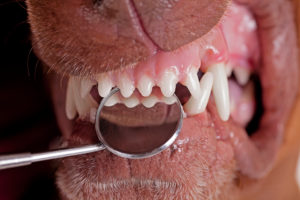
By: Cynthia Quezada, DVM
Did you know that the American Veterinary Medical Association has found that 80% of dogs and 70% of cats have some form of periodontal disease by the age of 3? Not only does periodontal disease cause bad breath, but it can lead to other, more significant health problems. In its advanced stages, periodontal disease can lead to oral pain, loose teeth, and damage to the kidneys, heart, and liver.
Periodontal disease occurs when plaque and tartar begin to accumulate under the gum line. This creates a biofilm for bacteria to attach and multiply. The inflammation triggered by the infection weakens and damages the surrounding connective tissue that holds the tooth in place. This tissue includes the gingiva, periodontal ligament, and the actual bone surrounding the root of the tooth. As periodontal disease advances, more of the root becomes exposed loosening the tooth. Not only is this painful, but patients with periodontal disease are also at higher risk for bacteria seeding into the blood stream which can harm other organ systems.
Fortunately, periodontal disease is preventable. Prevention starts with good and consistent at-home dental care, along with regular veterinary visits. There are several dental care options that pet owners can easily incorporate into their pet’s daily routine. Daily teeth brushing is considered the gold standard in helping keep pets’ teeth healthy. If your pet does not allow for proper teeth brushing, there are several dental chews available on the market that can also be quite effective in decreasing plaque and tartar build-up. Besides dental chews, prescription dental diets are also available, as well as oral rinses and water additives. If dental plaque and tartar are already present, a thorough dental cleaning under general anesthesia by your pet’s veterinarian may be necessary. It is important to speak to your veterinarian about which dental care options are best for your pet. Your veterinarian is also a great resource on which products are the safest and most effective to use. Another good resource is the Veterinary Oral Health Council (VOHC). Visit their website for a list of veterinary dental products that have been VOHC approved.
Regardless of which at-home dental care method you chose for your pet, it is important to start at an early age and to be consistent. This, along with professional anesthetic dental cleanings as needed, can help maintain excellent oral health in your pet.
